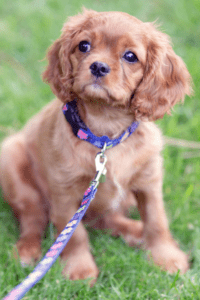Potty Training Your Puppy
Tips to Make Potty Training Easier
Whether you have adopted a new puppy or an adult dog, potty training as quickly as possible will likely be one of your primary goals. Before starting any training, have your pet examined by a veterinarian. It is important to make sure that your pet does not have any underlying medical conditions that will make it difficult for them to potty train. Many conditions, from bladder infections to bladder stones, can make it impossible for your new pet to hold their bladder. Conditions that cause excessive water consumption also make potty training extremely difficult. Soft or loose stools are not normal, even for a puppy, and may be caused by an infection. Discuss any symptoms that you are noting or concerns that you may have with our veterinary team.
It is important to understand that each puppy may be able to grasp the concept of potty training at a different age. This can be as young as three weeks or as old as three months. This means that although you are ready for potty training to progress quickly, your new friend may not be quite ready to learn yet. Following these guidelines will help to set your puppy on the proper path to make the jump when they are ready. It is also important to remember that your puppy has gotten used to eliminating whenever the urge hits them, and they often have not gained the capacity to hold their bladder for more than a few hours. Potty training can be a lengthy and frustrating process at times, and it is important to understand what we can reasonably expect as we begin.
For a newly adopted adult dog that needs to be potty trained, you will be working on teaching them that the system that they have been using their whole life is no longer appropriate, and you will need to teach them a new method of elimination. This may be confusing to them at first, but if you are consistent in your methods, you will make progress.
 In the initial stages, try to take your new pet out as frequently as possible. A good rule of thumb is to take them out every 2 hours, as well as 15-20 minutes after eating or drinking. Try to get them on a consistent feeding schedule 2-3 times per day to help make timing these trips easier. The immediate period after play or sleep is also a time when your pet may need to eliminate.
In the initial stages, try to take your new pet out as frequently as possible. A good rule of thumb is to take them out every 2 hours, as well as 15-20 minutes after eating or drinking. Try to get them on a consistent feeding schedule 2-3 times per day to help make timing these trips easier. The immediate period after play or sleep is also a time when your pet may need to eliminate.
Encourage your pet to eliminate quickly when going outside. Take them to the area in which you would like them to eliminate and wait 2-3 minutes. Be consistent and return to the same area each time. Leave the most recent stool in this area initially to provide a cue that this is an appropriate area to eliminate. Start to add a consistent command such as “bathroom” or “go potty” when you reach this location. If they fail to eliminate, go back inside and monitor them closely. Try again if they are exhibiting signs (circling, going to the door, whining, or wandering away from you are all signs they may need to go) or if 30 minutes have passed. When they have successfully eliminated, immediately praise them and provide them with a treat. Keep a bag of treats by the door so that they are easy to remember to bring on these trips. After elimination, allow some playtime in the yard some of the time. People often bring their pet inside immediately after elimination, ending their exploration of a new and fun area. This teaches them that when they eliminate, this trip is over. Try to teach them to eliminate first and that this will lead to playtime outside. This will allow you to teach them to eliminate first rather than procrastinate for as long as possible to avoid ending their time outside.
If your dog does eliminate in the house, interrupt them immediately with a sharp “no” or loud clap. Then take them out to the appropriate area. If they finish eliminating outside, they should be praised and given a treat as described above. If you do not witness the accident, clean it up and move on. It does not help to help to take them to the site of an accident and scold them. They will not understand what you are upset about, and this will serve to confuse them.
The true key to potty training is consistency. Every accident that you catch is a learning experience. Every time that they are praised for doing it correctly is a learning experience. If they are having large numbers of unwitnessed accidents in the house, this will typically slow the potty-training process significantly. If you are having trouble making progress, consult our team. We are happy to help!
No one can always be on duty and alert. It is okay to give yourself permission to use their crate as an area to contain them and prevent accidents during periods when you are home but are too busy to provide direct supervision. They need plenty of exercise and interaction, but quiet times in their crate with a favorite toy will help save your sanity as well as prevent unwitnessed accidents. See our resource on Crate Training for tips on acclimating your new pet to their kennel.
